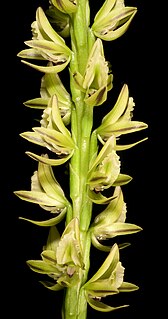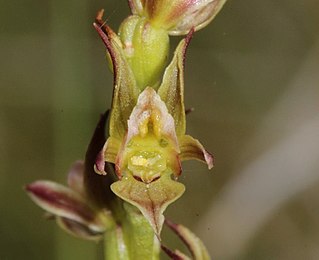Prasophyllum correctum, commonly known as the gaping leek orchid or Bairnsdale leek orchid, is a species of orchid species endemic to a small region in Victoria. It has a single dark green, tube-shaped leaf and up to twenty strongly scented, yellowish-green flowers and is only known from railway reserves near Bairnsdale.
Prasophyllum campestre, commonly known as the sandplain leek orchid, or inland leek orchid, is a species of orchid endemic to eastern Australia. It has a single tubular, yellowish-green leaf and up to twenty greenish, strongly scented flowers with red, purplish, brown or white marks. It grows in the drier parts of Queensland, New South Wales and Victoria.
Prasophyllum barnettii, commonly known as the Anglesea leek orchid, is a species of orchid endemic to Victoria. It has a single tubular leaf and between twelve and thirty scented yellowish, reddish or brownish flowers and is only known from a small area in the south of the state.

Prasophyllum brownii, commonly known as the Christmas leek orchid, is a species of orchid endemic to the south-west of Western Australia. It is one of the last of the genus in Western Australia to flower and has a tall flowering stem with up to eighty pale green and fawn-coloured flowers.
Prasophyllum candidum, commonly known as the Kiandra leek orchid, is a species of orchid endemic to eastern Australia. It has a single tubular, yellowish-green leaf and up to forty scented, bright white to greenish flowers. It grows in subalpine areas at altitudes above 1,000 m (3,000 ft) in New South Wales and Victoria although in the latter state it is considered to be a form of P. odoratum.
Prasophyllum concinnum, commonly known as the trim leek orchid, is a species of orchid endemic to Tasmania. It has a single tubular leaf and green or yellowish-green flowers with brown markings. It was not seen after 1947, presumed to have gone extinct and listed as "rare" under the Tasmanian Government Threatened Species Protection Act 1995 but was rediscovered in 1992. Flowering of this orchid is dramatically stimulated by summer fires and the species is now known to be widespread in the state and has been removed from the Act.
Prasophyllum brevilabre, commonly known as the Gorae leek orchid, is a species of orchid endemic to south-western Victoria. It has a single tubular, green leaf and up to forty greenish-brown flowers with reddish markings. It is a very rare orchid, now only known from two small, scattered populations. It was first recorded from Gorae West near Portland but is no longer found there.

Prasophyllum frenchii, commonly known as the maroon leek orchid or swamp leek orchid, is a species of orchid endemic to south-eastern continental Australia. It has a single tubular green leaf and up to sixty five green, reddish-brown or red flowers. Formerly more widespread, it is now confined to seven populations containing a total of fewer than 1,000 plants.
Prasophyllum laxum, commonly known as the lax leek orchid, is a species of orchid endemic to a small region of South Australia. It has a single tubular leaf and up to twenty pale green, tan and lilac-coloured flowers. It was first collected in the 1960s in a location known as the Hundred of Koppio on the Eyre Peninsula but was not described until 2008 from a new collection in 2004.
Prasophyllum litorale, commonly known as the coastal leek orchid, is a species of orchid endemic to southern continental Australia. It has a single tubular leaf and up to forty flowers with red and green colouring and grows in sandhills near the sea.

Prasophyllum maccannii, commonly known as the inland leek orchid, is a species of orchid endemic to Victoria. It has a single tubular green leaf and up to forty green, greenish-pink or brownish flowers. It is found in the central-west of the state, growing in open forest.
Prasophyllum morganii, commonly known as the Cobungra leek orchid, is a species of orchid endemic to a small area in Victoria. It has a single tubular leaf and up to eighty greenish flowers with purplish markings. It was known from a single population of fifteen plants but has not been seen since 1933 and is now presumed extinct.
Prasophyllum retroflexum, commonly known as the congested leek orchid or Kiandra leek orchid, is a species of orchid endemic to a small area near the border between New South Wales and Victoria, growing in subalpine herbfields. It has a single tubular leaf and up to forty densely-crowded, pale green flowers with pinkish markings.
Prasophyllum robustum, commonly known as the robust leek orchid, is a species of orchid endemic to Tasmania. It has a single tubular, green leaf and up to thirty greenish-brown flowers with a white labellum. It is only known from a single population of about fifty plants, its numbers having been reduced by land clearing.
Prasophyllum suaveolens, commonly known as the fragrant leek orchid, is a species of orchid species endemic to inland Victoria. It has a single bright green, tube-shaped leaf with a reddish base and up to twenty five green to yellowish-green flowers with red markings. The flowers are the smallest of any leek orchid found in Victoria.

Prasophyllum subbisectum, commonly known as the Pomonal leek orchid, is a species of orchid endemic to Victoria. It has a single, thin tubular leaf and up to fifteen small, greenish-brown to brown flowers well-spaced along a thin flowering stem. It is only known from a small area around Stawell.
Prasophyllum fitzgeraldii, commonly known as FitzGerald's leek orchid, is a species of orchid endemic to South Australia. It has a single tube-shaped leaf and up to thirty five green or reddish-brown flowers with a pink to purple labellum. It was previously thought to also occur in Victoria.
Prasophyllum roseum, commonly known as the pink lip leek orchid, is a species of orchid endemic to southern continental Australia. It has a single tube-shaped leaf and up to thirty greenish flowers with a pink labellum. It is a recently described plant, previously included with P. fitzgeraldii, but distinguished from that species by its smaller, less crowded flowers, with more spreading lateral sepals and different labellum callus. It grows in the south-east of South Australia and in western Victoria.
Prasophyllum spadiceum, commonly known as the brown lip leek orchid, is a species of orchid endemic to southern continental Australia. It has a single tube-shaped leaf and up to thirty pale green, brown and white flowers with a whitish labellum. It is a recently described plant, previously included with P. fitzgeraldii, but distinguished from that species by its smaller, paler flowers, whitish labellum and brown callus. It grows in the south-east of South Australia and in a single location in western Victoria.
Prasophyllum occidentale, commonly known as the plains leek orchid, is a species of orchid endemic to southern continental Australia. It has a single tubular leaf and up to twenty five small, pale yellowish-green flowers. It is found in South Australia and Victoria although regarded by some taxonomists as a South Australian endemic.




